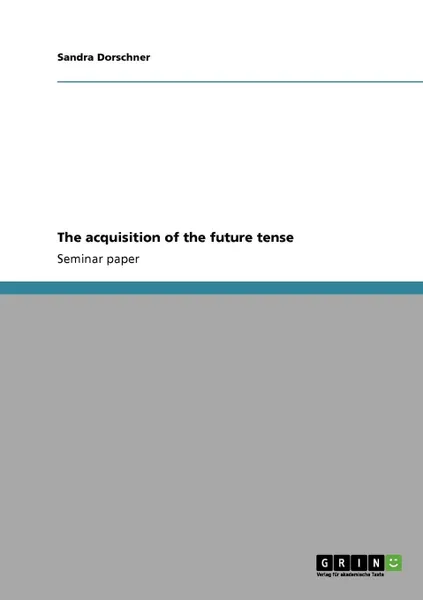The acquisition of the future tense 12+
Автор: Sandra Dorschner
68 страниц
Категория: Учебная литература
ISBN: 9783640172276
Язык: Английский
Где найти книгу?
📕 Seminar paper from the year 2006 in the subject English - Pedagogy, Didactics, Literature Studies, grade: 2,0, (Institut für Anglistik/Amerikanistik), course: Syntactic Development, 6 entries in the bibliography, language: English, abstract: It is the goal of this paper to examine the acquisition of the future tense in
children's speech. After a two word utterance stage they develop more and
more their speaking skills and start to talk about events and activities in the
future, apart from saying things about the present. To give a detailed account
of the acquisition of the future, this study includes several steps of
examination. It will not only try to answer to the questions, when children first
use future expressions and how their use develops in time. But it also includes
an analysis of the occurrence of future tense in specific constructions, such as
simple sentences, questions etc. It is also necessary to look at verbs as well as
subjects which occur with expressions of future tense. A last part of the study
is concerned with common errors children produce when speaking about the
future.
There exist several ways to express the future in adult grammar. The most
common forms, which are also the focus of this analysis, are the simple future
expressed by will and the going to-future. Other possibilities of expressing the
future, e.g. using simple present tense or a present progressive form of the
verb, will be neglected in this paper, as they are too complex in their concepts
for children. They mainly depend on adverbials of time to denote the future
and therefore would require a different focus of analysis.
The simple future is formed with the modal auxiliary will, followed by the
infinitive of a verb (e.g. Greenbaum 1991: 54), as in
(a) I will write the exam.
The will-future is used to convey two different concepts: first, it is used for
expressing general predictions and assumptions of what is going to happen in
the future and second, it
children's speech. After a two word utterance stage they develop more and
more their speaking skills and start to talk about events and activities in the
future, apart from saying things about the present. To give a detailed account
of the acquisition of the future, this study includes several steps of
examination. It will not only try to answer to the questions, when children first
use future expressions and how their use develops in time. But it also includes
an analysis of the occurrence of future tense in specific constructions, such as
simple sentences, questions etc. It is also necessary to look at verbs as well as
subjects which occur with expressions of future tense. A last part of the study
is concerned with common errors children produce when speaking about the
future.
There exist several ways to express the future in adult grammar. The most
common forms, which are also the focus of this analysis, are the simple future
expressed by will and the going to-future. Other possibilities of expressing the
future, e.g. using simple present tense or a present progressive form of the
verb, will be neglected in this paper, as they are too complex in their concepts
for children. They mainly depend on adverbials of time to denote the future
and therefore would require a different focus of analysis.
The simple future is formed with the modal auxiliary will, followed by the
infinitive of a verb (e.g. Greenbaum 1991: 54), as in
(a) I will write the exam.
The will-future is used to convey two different concepts: first, it is used for
expressing general predictions and assumptions of what is going to happen in
the future and second, it
Мнения
